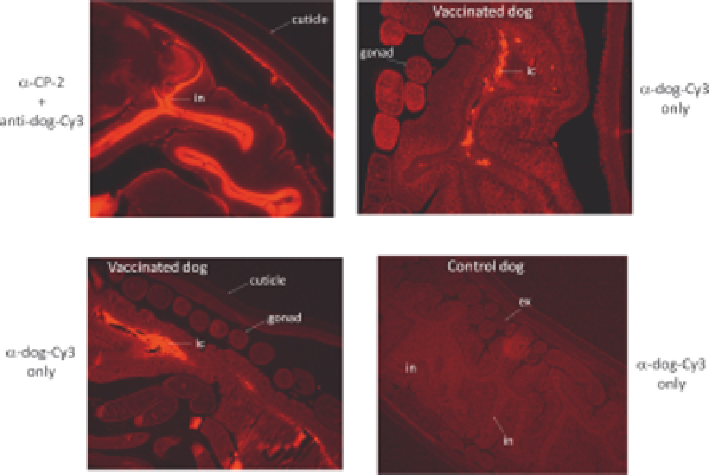Biomedical Engineering Reference
In-Depth Information
Figure 8.2
Antibodies binding to the intestinal brush-border membrane (in) and
intestinal contents (ic) of adult A. caninum in vitro and in vivo in dogs
vaccinated with Ac-CP-2. (A) Cross-section of an adult Ancylostoma can-
inum probed with dog anti-Ac-CP-2 serum followed by Cy-3-conjugated
anti-dog IgG. (B-D) Longitudinal sections of A. caninum recovered from a
dog that was vaccinated with either Ac-CP-2/alum (B and C) or alum alone
(D) and proved with Cy3-conjugated anti-dog antibody only (primary
antibody was not used). Taken from reference Loukas et al.
33
outputs of 77% and worm burdens of 47% compared to non-vaccinated ani-
mals.
35
The microvillar surface of worms that survived the vaccine trial and
were recovered from vaccinated lambs was coated with sheep immunoglobulin
that functionally inhibited the cysteine protease components of TSBP.
8
Three
cathepsin-B-like cysteine proteases present in TSBP (hmcp 1, 4, and 6) have
been isolated and expressed, and a cocktail vaccine consisting of equal pro-
portions of these proteins significantly reduced worm burdens by 38% upon
vaccination compared to controls.
36
8.2.3 Metalloproteases
Metalloproteases require the coordination of a divalent metal ion within the
active site in order to catalyze substrates, enabling the polarization of the target
scissile peptide bond before nucleophilic attack and subsequent cleavage. The
majority of parasite metalloproteases that have been identified to date are zinc
metalloproteases belonging to the clan MA and are defined by the presence of
an HEXXH motif in which the two His residues are zinc ligands, and the Glu is
responsible for catalytic function.
37

